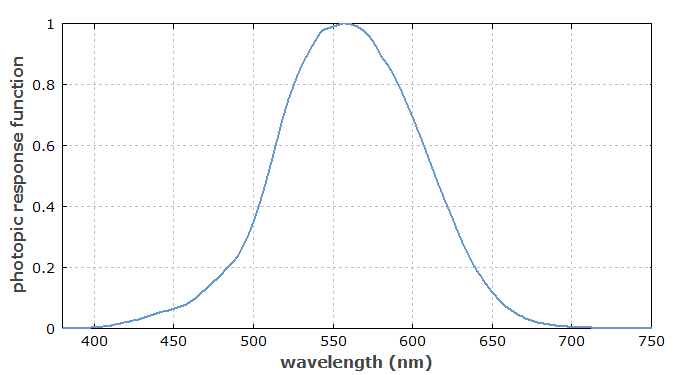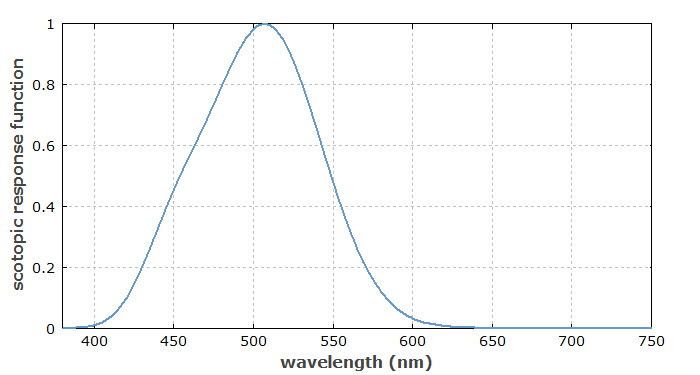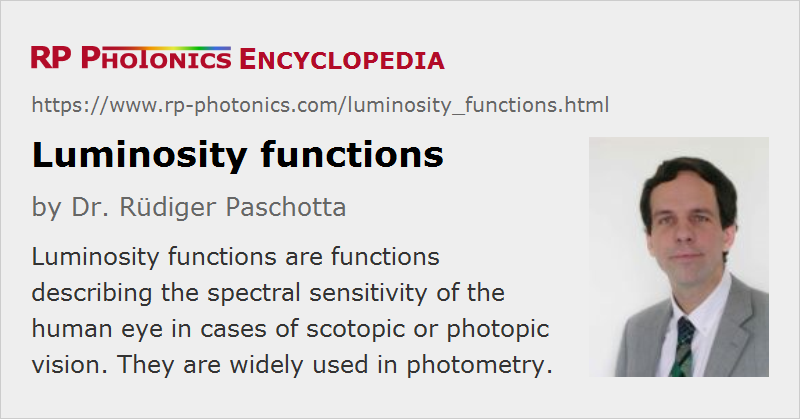Luminosity Functions
Definition: functions describing the spectral sensitivity of the human eye
German: Empfindlichkeitskurven
Category: vision, displays and imaging
How to cite the article; suggest additional literature
Author: Dr. Rüdiger Paschotta
Luminosity functions describe the spectral sensitivity of the human eye. Official versions of those have been published by CIE, the Commission Internationale de l'Éclairage (International Commission on Illumination); they are based on the average perceptions of human beings with healthy eyes under well-defined experimental conditions (for the CIE standard observer).
Importantly, the spectral dependence of the sensitivity of the human eye depends on the lighting conditions, more precisely on the incoming luminance. For luminance values below approximately 10−3 cd/m2, one has scotopic vision, which is monochrome. At better illumination conditions with a luminance of at least a couple of cd/m2, one has photopic vision with good color perception. The intermediate regime is called mesopic vision. For more details, see the article on scotopic and photopic vision.
There are substantially different luminosity functions for scotopic and photopic vision.
Luminosity Function for Photopic Vision
For photopic vision, i.e., at sufficiently highlighted levels, the human eye uses the cone receptors, of which it has three different kinds (L, M and S). Their output signals are combined to determine the total received brightness.
In the simple case of monochromatic light with some wavelength λ, the luminous flux produced by a light source can be calculated as 683 lm/W times the photopic luminosity function value y(λ) times the radiant flux (optical power). For polychromatic light, the luminous flux obtains contributions for all the spectral components, and can thus be calculated as a spectral integral:
where Φe(λ) is the spectral radiant flux entering the eye (within the opening of the iris) and Φv(λ) the resulting luminous flux. Figure 1 shows the values of the photopic luminosity function.

Losses of optical energy on the way from the cornea to the retina are included in the luminosity function. Due to aging of the eye, particularly shorter-wavelength components will experience increasing absorption and scattering losses, eventually resulting in lower luminosities than predicted by that function.
The luminosity function is scaled such that its maximum value, reached at a wavelength of approximately 555 nm, is unity; that results in the maximum response of 683 lm/W. For other wavelengths, and for any mixtures of different wavelengths, lower values result. In particular, white light sources, the output of which needs to contain some red and blue light, are more limited than green light sources in terms of luminous efficacy, even if the conversion from electrical energy to luminous flux is highly efficient.
Luminosity Function for Scotopic Vision
Scotopic vision occurs at low light levels, where only the rod photoreceptors are involved, because the cones are unable to provide sufficiently strong signals. In this regime, a different luminosity function called V'(λ) (defined by CIE in 1951) must be applied. That function is peaked at 507 nm, and is again normalized to be unity at that point. The luminous flux resulting from a certain radiant flux can be calculated as
where Φ(λ) is again the spectral radiant flux. (Figure 2 shows the values of the scotopic luminosity function.) One can see that much less light is required in that regime to obtain a significant light perception. However, color vision is then not possible.

Applications of Luminosity Functions
Based on the known luminosity functions and the known optical spectrum of a light source, one can calculate how bright a light source or an illuminated object can be perceived. For example, that allows one to calculate the luminous efficacy and efficiency of a light source if its efficiency for the conversion from electrical power to light power is known.
One may also use luminosity functions for comparing the apparent brightness of monochromatic light sources at a different wavelengths – for example, of laser pointers. Note that the ratio of luminosity values at two different wavelengths can be very different between scotopic and photopic vision. For example, while for photopic vision a 650-nm laser pointer can achieve at least more than 10% of the brightness of a green laser pointer with the same output power, the difference is much larger for scotopic vision, where the sensitivity at 650 nm becomes very small.
Questions and Comments from Users
Here you can submit questions and comments. As far as they get accepted by the author, they will appear above this paragraph together with the author’s answer. The author will decide on acceptance based on certain criteria. Essentially, the issue must be of sufficiently broad interest.
Please do not enter personal data here; we would otherwise delete it soon. (See also our privacy declaration.) If you wish to receive personal feedback or consultancy from the author, please contact him e.g. via e-mail.
By submitting the information, you give your consent to the potential publication of your inputs on our website according to our rules. (If you later retract your consent, we will delete those inputs.) As your inputs are first reviewed by the author, they may be published with some delay.
See also: photometry, luminous flux, luminous efficacy and efficiency, luminosity, chromaticity
and other articles in the category vision, displays and imaging
 |






If you like this page, please share the link with your friends and colleagues, e.g. via social media:
These sharing buttons are implemented in a privacy-friendly way!